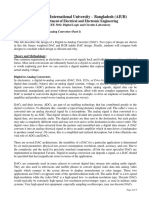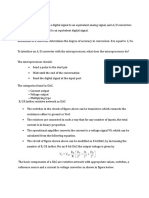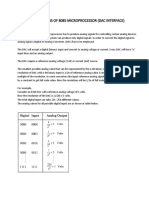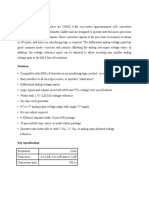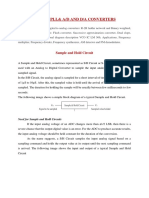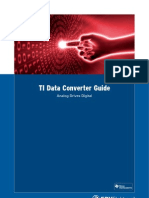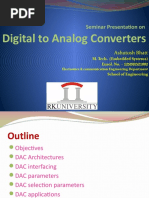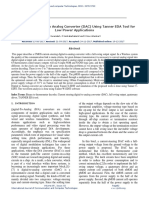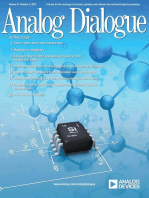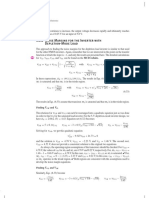El Amraouiyine Imad
El Amraouiyine Imad
Uploaded by
Imad EL AmraouiyineCopyright:
Available Formats
El Amraouiyine Imad
El Amraouiyine Imad
Uploaded by
Imad EL AmraouiyineOriginal Title
Copyright
Available Formats
Share this document
Did you find this document useful?
Is this content inappropriate?
Copyright:
Available Formats
El Amraouiyine Imad
El Amraouiyine Imad
Uploaded by
Imad EL AmraouiyineCopyright:
Available Formats
El Amraouiyine imad
WiMAX , the acronym of Worldwide Interoperability
for Microwave Access, is a technology created in 2004 corresponding to the standard 802.16 of IEEE. The aim of this new technology is to provide business and consumer broadband access on the scale of MAN (Metropolitan Area Network).It can be considered the evolution of the Wi-fi, since it offers higher data rates with coverage of up to 50 kilometers.
This is the history overview about the 802.16 standards: 802.16 (Dec 2001): Original fixed wireless broadband access
for the bands in the 10 66GHz. Line-of-sight (LOS) only and Point-to-Multi-Point (MPM).Maximum range of 5 Km 802.16c (2002): Amendement. WiMAX system profiles 1066GHz 802.16a (Jan 2003): Improvement for non-line-of-sight (NLOS) and providing last-mile access to a broadband Internet service provider (ISP). 802.16d (Oct 2004): Adds WiMAX system profiles. Maximum range of 50 Km 802.16e (Dec 2005): Layers PHY and MAC to enable moving subscribers. Maximum range of 5 km.
Analog to Digital converters, and their counterparts,
Digital to Analog converters are used all the time in electronics. Indeed, they provide the only method by which one may interface a digital system with the real world, which functions in analog.
Data converters are categorized as either Nyquist-rate or
oversampled architectures. The former class of converter includes architectures that are typically open-loop and that operate at sampling rates that (usually) do not exceed 10 times the Nyquist rate. The Nyquist-rate D/A converter is the basis of many architectures and is formed by a series of passive or active elements, switches, and an output buffer, Oversampled converters are feedback systems that operate with relatively high clock rates, up to 100 times the Nyquist rate or more. The kernel of the oversampled converter is the deltasigma modulator, which embeds a quantizer and filter within a feedback loop.
The flash or parallel converter, is perhaps the most
straightforward type of Nyquist-rate A/D. A thermometer-coded binary number is generated through approximately 2N parallel comparisons; conversion to conventional binary code (in addition to error correction) is performed by digital logic. The main advantage of this approach is speed.
The digital-to-analog (D/A) converter is one of the
basic building blocks of most analog/digital interface systems. For example, in Telecommunication applications like radio transmitters require D/A converters (DACs) operating at hundreds of MHz for resolutions in the range of 1015 bits. There are several architectures for D/A converters depending on the speed, resolution, complexity, and area requirement.
When data is in binary form, the 0's and 1's may be of
several forms such as the TTL (Transistor-Transistor Logic) form where the logic zero may be a value up to 0.8 volts and the 1 may be a voltage from 2 to 5 volts. The data can be converted to clean digital form using gates which are designed to be on or off depending on the value of the incoming signal. Data in clean binary digital form can be converted to an analog form by using a summing amplifier. For example, a simple 4-bit D/A converter can be made with a four-input summing amplifier.
2 Basic Approaches: Weighted Summing Amplifier R-2R Network Approach
One way to achieve D/A conversion is to use a
summing amplifier. This approach is not satisfactory for a large number of bits because it requires too much precision in the summing resistors. This problem is overcome in the R-2R network DAC.
We are going to start by examining a simple
circuit. This circuit is an operational amplifier circuit with three input voltages. Each input voltage is either zero volts or five volts and represents a logical 0 or 1. The input resistors are chosen so that they are not all equal. The resistors are related by: Rc = 2Rb = 4Ra.
Expression for the output voltage:
Vout = (RfVa /Ra) + (RfVb /Rb) + (RfVc /Rc) We have : Rc = 2Rb = 4Ra Then, the output voltage expression becomes: Vout = (RfVa /Ra) + (RfVb /2Ra) + (RfVc /4Ra) Each input voltage is either zero (0) or five (5) volts, representing either a zero or a one Va = 5A2 Vb = 5A1 then Vout = (5Rf/4Ra)(4A2 + 2A1 + Ao ) Vc = 5Ao.
The inputs can be thought of as a binary number, one that can run from zero (0) to seven (7). The output is a voltage that is proportional to the binary number input.
It uses resistors of only two different values. An N-bit
DAC requires 2N resistors, and they are quite easily trimmed. There are also relatively few resistors to trim.
The summing amplifier with the R-2R ladder of resistances
shown produces the output where the D's take the value 0 or 1. The digital inputs could be TTL voltages which close the switches on a logical 1 and leave it grounded for a logical 0. This is illustrated for 4 bits, but can be extended to any number with just the resistance values R and 2R.
A/D converters may be designed for voltages from 0 to
10v, from -5 to +5v, etc., but they almost always take a voltage input. The output of the A/D converter is a binary signal, and that binary signal encodes the analog input voltage. So, the output is some sort of digital number. 3 -Basic Types:
Digital-Ramp ADC
Successive Approximation ADC Flash ADC
Conversion from analog to digital form inherently involves
comparator action where the value of the analog voltage at some point in time is compared with some standard. A common way to do that is to apply the analog voltage to one terminal of a comparator and trigger a binary counter which drives a DAC. The output of the DAC is applied to the other terminal of the comparator. Since the output of the DAC is increasing with the counter, it will trigger the comparator at some point when its voltage exceeds the analog input. The transition of the comparator stops the binary counter, which at that point holds the digital value corresponding to the analog voltage.
It is the fastest type of ADC available, but requires a comparator for each value of output.(63 for 6-bit, 255 for 8-bit, etc.) Such ADCs are available in IC form up to 8-bit and 10-bit flash ADCs (1023 comparators) are planned. The encoder logic executes a truth table to convert the ladder of inputs to the binary number output.
The resistor net and comparators provide an input to
the combinational logic circuit, so the conversion time is just the propagation delay through the network - it is not limited by the clock rate or some convergence sequence.
You might also like
- Vanguard 37 Efi Repair ManualDocument150 pagesVanguard 37 Efi Repair ManualFrancis Kengne0% (2)
- Cynosure Starlux 500 Palomar Technical Service ManualDocument47 pagesCynosure Starlux 500 Palomar Technical Service ManualJF SilvaNo ratings yet
- Panasonic Air Conditioner Error CodesDocument4 pagesPanasonic Air Conditioner Error CodesGian Canales-Gutierrez100% (1)
- Digital-to-Analog Analog-to-Digital: Interface Part IV MicroprocessorDocument30 pagesDigital-to-Analog Analog-to-Digital: Interface Part IV MicroprocessorVineeth KumarNo ratings yet
- 8 A-D ConverterDocument30 pages8 A-D Converterneoloader145No ratings yet
- Lab Manual DAC-SignedDocument10 pagesLab Manual DAC-Signedabidrk_21789100% (2)
- DLC Lab - 10Document7 pagesDLC Lab - 10Didarul Alam AlifNo ratings yet
- Ch3_2 SignalConditioning (1)Document19 pagesCh3_2 SignalConditioning (1)Mohammad alhaboob2030No ratings yet
- Analog-To-Digital Conversion Btech IIIDocument50 pagesAnalog-To-Digital Conversion Btech IIILisa BhagatNo ratings yet
- DEC LAB 06 (Design of A Digital To Analog Converter)Document9 pagesDEC LAB 06 (Design of A Digital To Analog Converter)anon_776365175No ratings yet
- ADC and DACDocument4 pagesADC and DACjeniferNo ratings yet
- Adc DacDocument22 pagesAdc DacyaniNo ratings yet
- Adc DacDocument22 pagesAdc DacPrasad ChikkamNo ratings yet
- A D ConverterDocument20 pagesA D ConverterRenu TyagiNo ratings yet
- Design and Simulation of DAC On The Basis of Capacitor ArrayDocument4 pagesDesign and Simulation of DAC On The Basis of Capacitor ArrayAmitNo ratings yet
- Analog To Digital & Digital To Analog ConvertersDocument66 pagesAnalog To Digital & Digital To Analog ConvertersSai Krishna Kodali100% (1)
- A4Document9 pagesA4rabbaswpcNo ratings yet
- Analog To Digital Converter PDFDocument4 pagesAnalog To Digital Converter PDFtowfiqeeeNo ratings yet
- Adc DacDocument12 pagesAdc DacSonu SauravNo ratings yet
- UNIT 5Document21 pagesUNIT 5princessconsuelacrapbag1903No ratings yet
- Important Q&A-Unit-4Document26 pagesImportant Q&A-Unit-4dailybhaktifeedNo ratings yet
- DA ConverterDocument13 pagesDA Converterdivya sainiNo ratings yet
- Applications of 8085 Microprocessor Dac InterfaceDocument4 pagesApplications of 8085 Microprocessor Dac InterfaceSai PrakashNo ratings yet
- Adc DacDocument34 pagesAdc DacvpNo ratings yet
- DLC LAB - 10 - Student - ManualDocument8 pagesDLC LAB - 10 - Student - ManualImtiaj SajinNo ratings yet
- Data ConversionDocument4 pagesData ConversionpauliNo ratings yet
- Adc Dac Converter NewDocument50 pagesAdc Dac Converter NewJaya PaulNo ratings yet
- Digital Electronics-10 PDFDocument8 pagesDigital Electronics-10 PDFTapas BanerjeeNo ratings yet
- Adc - DacDocument4 pagesAdc - DacShaheer TariqNo ratings yet
- Nama: Refin Ananda NIM: 3.32.17.0.20 Kelas: EK-3A Individual Presentation 2 Analog To Digital Converter 1. The Meaning of ADCDocument4 pagesNama: Refin Ananda NIM: 3.32.17.0.20 Kelas: EK-3A Individual Presentation 2 Analog To Digital Converter 1. The Meaning of ADCRifky Yoga PratamaNo ratings yet
- Chapter 1 IntroductionDocument39 pagesChapter 1 IntroductionNivedini KuttiNo ratings yet
- Mdigicomm (1) (1) (1) - 241022 - 205410Document145 pagesMdigicomm (1) (1) (1) - 241022 - 205410abeda4772No ratings yet
- Adc 0804Document5 pagesAdc 0804gouttNo ratings yet
- Unit5 - ADC - DAC - Notes - Unit 5Document16 pagesUnit5 - ADC - DAC - Notes - Unit 5Chinmai NimgadeNo ratings yet
- Dec Exp 6 Student ManualDocument5 pagesDec Exp 6 Student ManualSakib MahmudNo ratings yet
- TOPIC 6 - (Converter)Document45 pagesTOPIC 6 - (Converter)Zulkiffli Mohd YusoffNo ratings yet
- Analog To Digital ConverterDocument11 pagesAnalog To Digital ConverterFf Fr100% (1)
- Chapter 5Document42 pagesChapter 5Ram Bahadur KhadkaNo ratings yet
- DACDocument28 pagesDACRohith Mohan100% (1)
- Design of Analog To Digital Converter To AcquireDocument13 pagesDesign of Analog To Digital Converter To AcquireKingHassan NawazNo ratings yet
- CND202 MidtremDocument15 pagesCND202 MidtremMayar Magdy MorkosNo ratings yet
- integratedelectronicsUNIT 3convertersDocument11 pagesintegratedelectronicsUNIT 3convertersYogeshwaranNo ratings yet
- Interfacing To The Analog WorldDocument47 pagesInterfacing To The Analog WorldRM ZhaloNo ratings yet
- Sar AdcDocument40 pagesSar AdcNivedini KuttiNo ratings yet
- Fig 1.1. ADC As An Interface Between Physical World and Digital ProcessorsDocument51 pagesFig 1.1. ADC As An Interface Between Physical World and Digital ProcessorsSupriyo SrimaniNo ratings yet
- DAQDocument34 pagesDAQKhairul FahzanNo ratings yet
- TI Data Converter GuideDocument16 pagesTI Data Converter GuideDavid PostonNo ratings yet
- Simu Exp5Document4 pagesSimu Exp5Ali MhadatNo ratings yet
- BIT102 SLM Library - SLM - Unit 12Document15 pagesBIT102 SLM Library - SLM - Unit 12pavanmay227597No ratings yet
- Adc 0808Document6 pagesAdc 0808src e-solutionsNo ratings yet
- Dac Interface To 8051 PDFDocument4 pagesDac Interface To 8051 PDFRAVI100% (1)
- ZozoDocument5 pagesZozoZozo BaryNo ratings yet
- Design of Low Power 4-Bit Flash ADC Based On Standard Cells: Marcel Siadjine Njinowa, Hung Tien Bui François-Raymond BoyerDocument4 pagesDesign of Low Power 4-Bit Flash ADC Based On Standard Cells: Marcel Siadjine Njinowa, Hung Tien Bui François-Raymond BoyerSunil PandeyNo ratings yet
- Digital To Analog and Analog To Digital Conversion: D/A or DAC and A/D or AdcDocument50 pagesDigital To Analog and Analog To Digital Conversion: D/A or DAC and A/D or AdcsomosreeNo ratings yet
- Digital To Analog ConvertersDocument25 pagesDigital To Analog ConvertersAshutosh BhattNo ratings yet
- Adc ConversionDocument20 pagesAdc Conversionhemantec100% (1)
- Digital-to-Analog Analog-to-Digital: Dr. Syed Faiz AhmedDocument69 pagesDigital-to-Analog Analog-to-Digital: Dr. Syed Faiz AhmedmuraliNo ratings yet
- Methods of Analog To Digital ConvertionsDocument11 pagesMethods of Analog To Digital ConvertionsProsper RighendaNo ratings yet
- Dac PDFDocument7 pagesDac PDFsanthoshNo ratings yet
- Bel - 16 - ADC and DACDocument26 pagesBel - 16 - ADC and DACBharavi K SNo ratings yet
- High-Performance D/A-Converters: Application to Digital TransceiversFrom EverandHigh-Performance D/A-Converters: Application to Digital TransceiversNo ratings yet
- Reference Guide To Useful Electronic Circuits And Circuit Design Techniques - Part 1From EverandReference Guide To Useful Electronic Circuits And Circuit Design Techniques - Part 1Rating: 2.5 out of 5 stars2.5/5 (3)
- Subject Code-Subject Name - Power Quality Improvement Programme: B.Tech - EEDocument2 pagesSubject Code-Subject Name - Power Quality Improvement Programme: B.Tech - EEDharmdasNo ratings yet
- Transformer ProtectionDocument21 pagesTransformer ProtectioncalecaleNo ratings yet
- IMaster-U1 User ManualDocument43 pagesIMaster-U1 User Manualmandegar companyNo ratings yet
- Practical TransformerDocument9 pagesPractical TransformerCJP TVNo ratings yet
- Electrical MaintenanceDocument74 pagesElectrical Maintenancemedassan7No ratings yet
- Mounting Instructions For The '123ignition': ImportantDocument4 pagesMounting Instructions For The '123ignition': ImportantclmarinNo ratings yet
- Analog Circuits - InddDocument98 pagesAnalog Circuits - Indddeepthi1993No ratings yet
- Ate 15090371Document9 pagesAte 15090371Juan Sebastián Londoño MartínezNo ratings yet
- Casio Cash Register SE-C6000Document134 pagesCasio Cash Register SE-C6000Robert MendozaNo ratings yet
- Guideline For Adoption of CMEN Earthing System: Purpose and ScopeDocument14 pagesGuideline For Adoption of CMEN Earthing System: Purpose and ScopeTerex14253No ratings yet
- Nmos Depletion InverterDocument2 pagesNmos Depletion InverterHemant SaraswatNo ratings yet
- Emerson UPSDocument88 pagesEmerson UPSserkalemtNo ratings yet
- Form Cable Pulling & Megger FIX CFEDocument13 pagesForm Cable Pulling & Megger FIX CFEPutraArifWardhanaNo ratings yet
- 3RU61161JB0 Datasheet enDocument6 pages3RU61161JB0 Datasheet enResta FauziNo ratings yet
- Reyrolle 5 Catalog Edition 6Document86 pagesReyrolle 5 Catalog Edition 6Jonas SilvaNo ratings yet
- Module 2 Handout Practice Exam QuestionsDocument11 pagesModule 2 Handout Practice Exam QuestionsSishir HumagainNo ratings yet
- Switching With CD4066 - All About CircuitsDocument29 pagesSwitching With CD4066 - All About CircuitsJimi KtuluNo ratings yet
- Neutral Start Switch MalfunctionDocument3 pagesNeutral Start Switch Malfunctioncelestino tuliaoNo ratings yet
- EFP1 Single Zone Conventional Fire Alarm PanelDocument2 pagesEFP1 Single Zone Conventional Fire Alarm PanelSameera LakmalNo ratings yet
- Manual de Instalación WatchDOGDocument2 pagesManual de Instalación WatchDOGLuisHernandezHernandezNo ratings yet
- NT10 BrochureDocument12 pagesNT10 Brochuremaykoll edwards ortiz castilloNo ratings yet
- ANT-AQU4518R8v06-1444-001 DatasheetDocument2 pagesANT-AQU4518R8v06-1444-001 DatasheetstaseklukasNo ratings yet
- Wires and Cables PDFDocument14 pagesWires and Cables PDFRomel Panis88% (8)
- AC CircuitDocument210 pagesAC CircuitRagilNo ratings yet
- PSV3St - Phase-Sequence Voltage Protection Stage1 (PSV3St1) Stage2 (PSV3St2)Document29 pagesPSV3St - Phase-Sequence Voltage Protection Stage1 (PSV3St1) Stage2 (PSV3St2)rajeshNo ratings yet
- Acti 9 iEM3000 - A9MEM3255Document3 pagesActi 9 iEM3000 - A9MEM3255Lucia TrifanNo ratings yet
- BEE Unit-1Document20 pagesBEE Unit-1yashNo ratings yet






